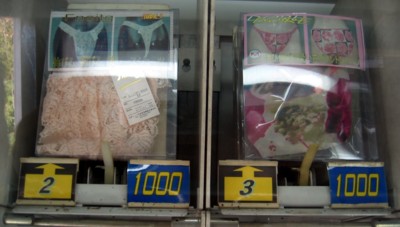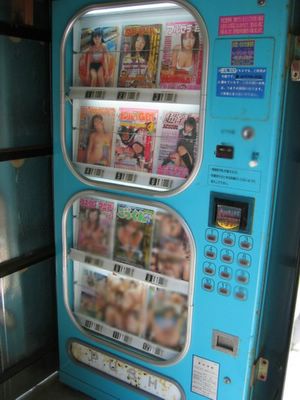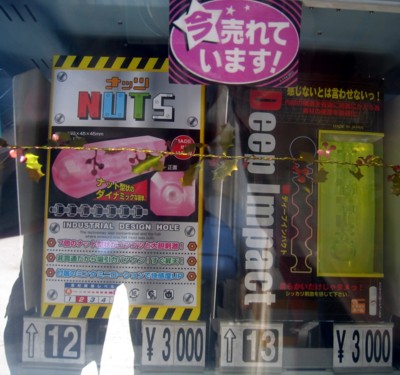Friday, May 27, 2005
Before touching down in Nippon, I’d heard about the existence of porn vending machines. However, it took almost eight months of living here before one finally crossed my path. This little booth was included as part of the Fukui car rally treasure hunt and is situated in the south of the Fukui prefecture – though I expect there are many more around.
Inside, a variety of adult magazines and toys could be purchased from the vending machines, as well as women’s knickers, and high school girls uniforms. The booth itself was located in the middle of nowhere on the side of the road, and was aptly named “House of Fun”.
Japan is well known for it’s vending machines, with soft drinks machines being by far the most abundant, appearing every few hundred meters, and beer and sake machines also common. I have also heard of vending machines that sell more bizarre products such as live rhinocirros beetles as pets, dry ice, and kerosene, though I am yet to see these myself.
Coming soon on thefunkydrummer – The Haku San hike. This will be the last in the series of Snow Stories until next winter. In short, it was tougher than Fuji, but a lot more fun coming down.
Stay Tuned.
Wednesday, May 18, 2005
Since bringing you one of the rudest vehicles of all time, (see November archives), I’ve been scouring the streets of of Fukui, looking for something which could come close to that original find.
Last week, I finally found what I sought. At a local festival, I spotted these two cars parked up, close to a gang of mullet haired youths. Though the cars themselves are nothing special, (besides the pink paint job) the 3m vertical exhausts pipes are surely worthy of documentation.
Whilst snapping these cars, the bad boy owners stood proudly close by, glad to see that their pride and joy were finally getting the international recognition that they deserved.
These are going to be hard to top, but you never know what crazy car customisation those Jap youngsters are going to come up with next, so there’s hope for even greater things yet.
Friday, May 13, 2005
I bet you used to complain about school dinners didn’t you? Unless you were one of the “sandwich kids” who’s mummy used to make them a packed lunch in a box that reeked when opened, you will have been subjected to school dinners for most of your days in compulsory education.
You may have thought that you were hard done by, receiving below par meals, with perhaps only two choices of main course, but spare a thought for the Japanese kids. If anyone has the right to complain about school dinners, it’s them.
Firstly, there is no choice of meal, you get what’s on the menu. There is no choice of quantity, everybody gets the same, and you must eat everything, down to the last grain of rice, after all, each grain contains seven gods, don’t you know?
It’s also worth noting that kids are completely banned from bringing food of any sort into school, so there’s no snacking on crisps or chocolate. The advantage of the Japanese system is that they eat much more healthily than their western counterparts, which probably explains the very obvious lack of any overweight students. This installs from an early age the importance of a healthy, balanced diet which they seem to take throught to adulthood.
The meals themselves are a fairly bizarre mix of foods. Rice and a bottle of warm, fatty milk are the staples, in fact rice is eaten with every meal here, from breakfast to supper. Once in a while, a small stick of bread substitutes for rice, but the Japanese don’t seem to differentiate between sweet and savoury to the same extent that we do.
The bread almost always comes with jam, and sometimes is even covered in chocolate powder and it’s common to receive a lump of fish on the same plate as a slice of fruit. They also use the same chopsticks/spoon for all of the meal, which saves on washing up, but it's not very appetizing when you’ve got to eat a fruit yoghurt with the your fish soup spoon.
Most of the time I eat everything, but occasionally, when I just can’t stomach the squid soup or daikon (a large vegetable that when boiled, smells and tastes like a fart), I am forced to mount an undercover “binning” run. Carefully surveying the staff room, I wait for my window, and when the coast is clear, I make a dash for the bin and donate the offensive fodder to the garbage gods.
Tuesday, May 10, 2005
Last week there was a three day national holiday here known as Golden week. It is a time when almost all Japanese hit the road and visit one of many famous “must see” tourist attractions of Japan, and thus can be a nightmare time to travel due to the swarms of photo hungry people desperate to capture the proof that they witnessed a famous temple, or so called “beautiful view”, in order to tick it off the list.
In a move to avoid getting caught up in all this, yet still wanting to get away for a few days, Sam and I jumped in the car and headed north, to the prefecture above Fukui (Ishikawa) which has a long peninsular jutting in the sea called Noto-Hanto.
Most of the area is fairly beautiful; a mixture of long sandy beaches and small fishing villages line the coastal road which winds up and down the mountains following the sea. As the area is not famous for anything particular, it is spared from the crowds that descend on the guide book destinations, so made a perfect spot for some serious relaxation.
We took three days to ride the coastal roads, spending the nights camping at camp sites, and the days lazing in the sun on empty beaches or wandering around fishing villages.
Japan certainly has a lot of nice beaches, and although many have be ruined by the building of factories or nuclear power plants well within view, the peninsular is relatively untouched.
The journey was also a nice taster of a planned road trip for the summer when I hope to head northwards to escape the summer humidity of Fukui, and explore the mighty island of Hokkaido.
Friday, May 06, 2005
New Link to UK Snowboarding Mag
Those who are snow inclined should check out the online snowboarding mag "Step-On". A stylish affair, packed full of slick graphics, detailed reviews, and interesting articles on all manner of snow related topics, with a heavy British slant.
The latest edition (no. 25) is out this week, and features an article by yours truly about the snowboarding scence in Japan, entitled Snowboardin Sushi Style.
Check it out: www.step-on.co.uk
Monday, May 02, 2005
All but the highest peaks have now lost their white caps, as temperatures in Fukui rise steadily. This week saw highs of 27C with most days feeling like a good English summer day, and it's hard to believe that just over a month ago there was a foot of snow on the ground. A couple of weeks ago the backcountry trio consisting of me, the American Brandon, and our local Japanese mountain man Yasu took to a mountain in the south of Ono called Ginampo.
My illusions of the majestically sounding name of this mountain were shattered when Yasu explained to us that Ginampo was a type of nut that was to be found growing in the area, so the name roughly translates as "Peanut Mountain".
As with the last trip to Kyogadake mountain (see April 2005 archives),
we started the ascent on a logging road before taking to the steeper slopes. Yasu climbs this mountain every spring, and told us that this year we were a little later than usual, as you can normally ski all the way back to the cars. Instead, it took us a good half hour to reach consistent snow.
This was the second time that Brandon and I had climbed this mountain. Back in November, we had come up to scope out the backcountry potential after the tip off from Yasu, so here we were fulfilling our own prophecy.
Although we were carrying snow shoes with us, the spring snow was solid enough not to require the use of them. Some of you may be pleased to hear that Yasu now has some new snow shoes. Perhaps he felt his old ones were a little too heavy weight, so he now has some even lighter weight bamboo framed shoes, that look like they were made from twigs.
We slowly hiked in and around trees, along and up ridges, and over streams, before summiting at 1441m some three hours later on a flat and open peak that resembled an Antarctic landscape. Again blessed with a blue bird day, we admired the views from the top as Yasu cracked a celebratory beer and we ate lunch.
The ride down was great, and reminded me how much I miss being on a board. A wide treeless chute was our route back down to earth, and carefully avoiding the occasional rock and stream we fired down the slope, enjoying the warm sun on our faces and spring snow at our feet. We all agreed that in deep powder this slope would be amazing, so I hope to be back next winter to throw up a spray.
We have one last trip planned before the snow disappears for good - and that is to the mighty mountain of Haku San, one of the most famous in Japan. Conditions permitting, we will be tackling this beast in a couple of weeks time, so stayed tuned for the next installment of Backcountry Boarding, Japan.
Coming soon on thefunkydrummer - the infamous Japanese porn vending machines.




























